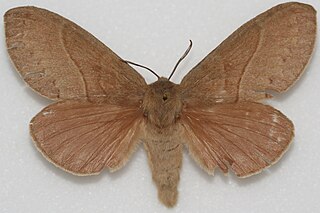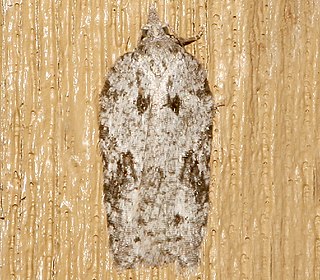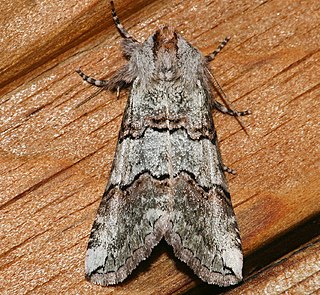Related Research Articles
Chrismania is a monotypic moth genus of the family Crambidae. Its only species, Chrismania pictipennalis, is found in North America, where it has been recorded from southern California and Arizona. Both the genus and species were first described by William Barnes and James Halliday McDunnough in 1914.

Dicogaster is a genus of moths in the family Lasiocampidae first described by William Barnes and James Halliday McDunnough in 1911. Its only species, Dicogaster coronada, was first described by Barnes in 1904. It is found in Arizona.

Idia diminuendis, the orange-spotted idia, is a litter moth of the family Erebidae. The species was first described by William Barnes and James Halliday McDunnough in 1918. It is found in North America from Wisconsin to Nova Scotia, south to Florida and Texas.
Renia nemoralis, the tardy renia or chocolate renia moth, is a litter moth of the family Erebidae. It is found in the US from Illinois to south-eastern Massachusetts south to Florida and Texas. The species was first described by William Barnes and James Halliday McDunnough in 1918.

Hyperstrotia pervertens, the dotted graylet, is a moth of the family Erebidae. The species was first described by William Barnes and James Halliday McDunnough in 1918. It is found in woodlands and forests of North America from Missouri to Nova Scotia, south to Florida and Texas. It is found in New Brunswick, Nova Scotia, Quebec and Ontario in Canada. In the United States, it has been recorded in Massachusetts, Iowa, New York and South Carolina.

Calephelis perditalis, the rounded metalmark or lost metalmark, is a butterfly in the family Riodinidae. It is found in Texas in the United States and Mexico, south to Venezuela. The species was first described by William Barnes and James Halliday McDunnough in 1918.

Euphilotes rita, the rita blue or desert buckwheat blue, is a species of butterfly of the family Lycaenidae. It is found in Wyoming, Colorado, Arizona, New Mexico and northern Mexico. The species was first described by William Barnes and James Halliday McDunnough in 1916.

Cahela is a monotypic snout moth genus described by Carl Heinrich in 1939. Its only species, Cahela ponderosella, the cahela moth, described by William Barnes and James Halliday McDunnough in 1918, is found in Mexico and in the US states of California, Texas, Arizona, Utah and probably Nevada.
Eremberga leuconips is a species of snout moth in the genus Eremberga. It was described by Harrison Gray Dyar Jr. in 1925 and is found in the US states of Arizona and California.
Decaturia is a monotypic snout moth genus. Its only species, Decaturia pectinalis, is found from California to southern Arizona. Both the genus and species were described by William Barnes of Decatur, Illinois, and James Halliday McDunnough in 1912.
Yosemitia graciella is a species of snout moth in the genus Yosemitia. It was described by George Duryea Hulst in 1887. It is found in the US states of Arizona, California, Nevada, Colorado, New Mexico and Texas.
Macrorrhinia parvulella is a species of snout moth in the genus Macrorrhinia. It was described by William Barnes and James Halliday McDunnough in 1913 and is known from the US states of Florida and South Carolina. It is also found in Colombia.

Givira lotta, the pine carpenterworm moth, is a moth in the family Cossidae. The species was first described by William Barnes and James Halliday McDunnough in 1910. It is found in the United States, where it has been recorded from California, Arizona, New Mexico and Colorado. The habitat consists of pine forests.
Thaumatopsis floridella, the Floridian grass-veneer, is a moth in the family Crambidae. It was described by William Barnes and James Halliday McDunnough in 1913. It is found in North America, where it has been recorded from coastal areas in Florida, Georgia, Mississippi, New Jersey, North Carolina and South Carolina. It is also found in Cuba.
Xubida dentilineatella is a moth in the family Crambidae. It was described by William Barnes and James Halliday McDunnough in 1913. It is found in Mexico and the southern United States, where it has been recorded from Arizona.

Acleris maximana is a species of moth of the family Tortricidae first described by William Barnes and August Busck in 1920. It is found in North America, where it has been recorded from Alberta, British Columbia, California, Maryland, Massachusetts, Montana, New Brunswick, North Carolina, Ontario, Pennsylvania, Saskatchewan, Tennessee, Utah and Washington.
Frechinia laetalis is a moth in the family Crambidae. It was described by William Barnes and James Halliday McDunnough in 1914. It is found in North America, where it has been recorded from eastern Washington and Oregon to Utah, southern California and western Texas.
Choristostigma zephyralis is a moth in the family Crambidae first described by William Barnes and James Halliday McDunnough in 1914. It is found in North America, where it has been recorded from California.

Dasychira vagans, the variable tussock moth, is a moth of the family Erebidae. It is found in North America, where it has been recorded from Newfoundland to southern British Columbia in the north and North Carolina and Utah in the west. The habitat consists of forests, including coastal rainforests, high elevation mixed hardwood-conifer forests, oak woodlands and mixed hardwood forests. The species was first described by William Barnes and James Halliday McDunnough in 1913.

Ceranemota fasciata is a moth in the family Drepanidae. It was described by William Barnes and James Halliday McDunnough in 1910. It is found in North America, where it has been recorded from British Columbia to northern California. It is also present in coastal southern Alaska. The habitat consists of coastal rainforests, mixed hardwood forests and montane riparian areas.
References
- ↑ Nuss, M.; et al. (2003–2011). "GlobIZ search". Global Information System on Pyraloidea. Retrieved September 29, 2011.
- ↑ "800589.00 – 5991 – Echinocereta strigalis – (Barnes & McDunnough, 1912)". North American Moth Photographers Group. Mississippi State University. Retrieved June 25, 2018.
- ↑ The cactus-feeding Phycitinae: A contribution toward a revision of the American pyralidoid moths of the family Phycitidae Archived August 12, 2014, at the Wayback Machine
- ↑ Phylogeny of the cactus-feeding phycitines and their relatives (Lepidoptera, Pyralidae) based on adult morphology: Evaluation of adult character-systems in phycitine systematics and evidence for a single origin of Cactaceae-feeding larvae